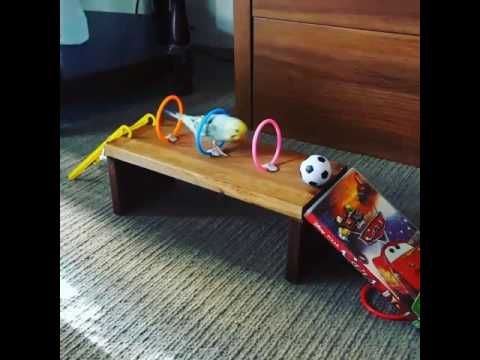Is it possible to train a parakeet to do basic commands or even more complicated tricks? It is! Even tiny budgies are very smart and responsive to training. If you’re wondering how to train a parakeet, keep reading to find out how to get started.
We’ll also go into some tricks to try and teach your ‘keet once you have the basics down!
This post contains affiliate links. If you make a purchase, a small percentage will go directly to Psittacology at no additional cost to you. Thank you for supporting Psittacology!
What is positive reinforcement?
Parrots, including parakeets, are incredibly smart as far as birds go. Their problem-solving skills are amazing and they’re naturally curious. Training yours is a way to harness this intelligence, ensure that “unwanted” behaviors like biting don’t develop, and strengthen your bond.
The most efficient way to train a parakeet is through positive reinforcement, so let’s take a moment to find out what exactly this is.
As expert animal trainer Barbara Heidenreich explains, positive reinforcement involves training by rewarding good behaviors rather than dealing punishment for bad ones.
When it comes to parakeets, the most coveted reward is, of course, a treat. Parrots are very food motivated, making it the perfect aid in training them. If you have a strong bond with your bird, then even the attention in itself will be a reward!
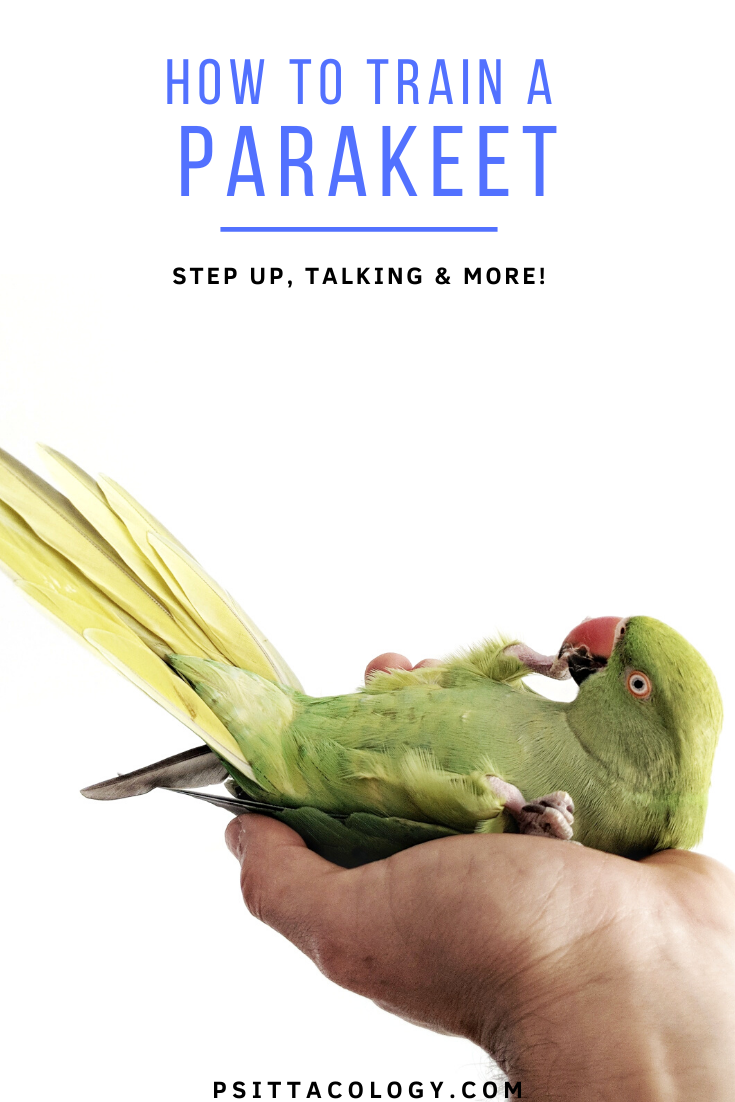
Why doesn’t negative reinforcement work?
When you’re training your parakeet, you need to remember that these birds do not respond well to punishment. Negative reinforcement (teaching by means of punishing mistakes) is simply not the way to go! There are multiple reasons for this.
First off, if you yell at your parakeet when it does something wrong, it might interpret this as a reward. After all, you’re giving attention and parrots tend to love noise.
If you put your bird back in its cage when it bothers you, it might start seeing its cage as something negative. This can make it unwilling to go in at all.
If you inflict more severe punishment, like hitting your bird, you’ll end up with a traumatized pet. This can cause it to start lashing out, bite, scream excessively, and even pluck its own feathers.
Did you know? Here at Psittacology headquarters, positive reinforcement helped our two budgies go from extremely skittish to happy, relaxed birds that eat from your hand, will come when called and even learned to jump through a little hoop!
How to train a parakeet step 1: Taming
The first step in how to train a parakeet is making sure that your bird is comfortable around humans. If your parakeet is hand-raised then this might already be the case. However, many birds (especially budgies) bought at pet stores will not be used to humans and can be extremely skittish.
So how do you turn a scared and nervous parakeet into a happy, social bird? Don’t worry, it can be done, even if it seems like a last cause.
Everyone’s experience will vary and you need a good dose of patience, but you could try the following two-part approach:
Part 1: Getting used to each other
Don’t try to touch your new parakeet yet—give it some time to settle in. Spend plenty of time with it, though: sit with your bird, talk to it or even sing it some songs!
Keep doing this until the bird seems okay with your presence (not positioning itself as far away as possible, not spooked by your every movement, etc.).
Part 2: Introduce your hands
Once your parakeet seems comfortable, you can move on to trying to hand-feed it. Take its favorite treat and present it to the bird in your hand. Then wait. Don’t move towards your parakeet, but wait until it comes to you.
You might be there for ages and have to try multiple times, but most parakeets’ stomachs will eventually get the better of them! Keep repeating daily.
It’s important not to try to get your bird to step up or attempt to give it neck scratches until it seems comfortable. Reward every positive interaction with a yummy treat.
Can you see how positive reinforcement comes into play in the steps above? You want your parakeet to associate your hands with positive events, like the appearance of treats. Negative events, like being forced into a corner so it has nowhere to go but your finger, will only give the opposite effect.
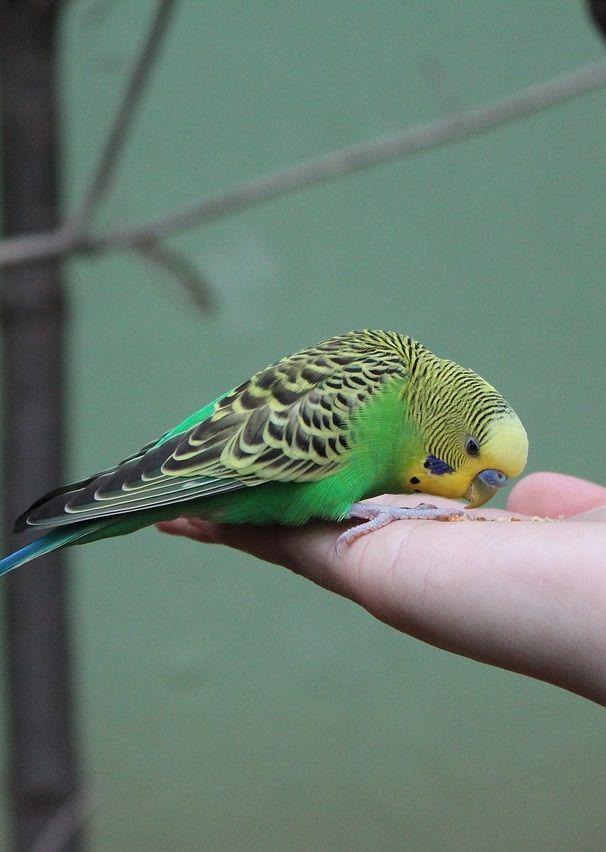
How to train a parakeet step 2: The basics
So, you’ve spent lots of time with your parakeet and it now seems pretty comfortable around you. Let’s move on to learning how to train a parakeet to perform basic exercises that can help make both your lives easier! After all, training is not just about funny tricks, it can be very useful.
The most commonly taught useful trick is ‘step up’: teaching your parakeet to step onto your finger on command. With positive reinforcement in mind, the idea is simple enough.
- Place a treat in your hand. Place your finger between the bird and the treat so it has to step up to reach its prize.
- Say in a clear and non-threatening voice: ‘step up!’, or any other auditory command you want. Just like you would tell a dog to ‘sit!”.
- Once the bird steps onto your hand, say something like ‘good bird’ or use a pet training clicker. Do this every time the exercise is performed correctly and then follow with a treat.
- Once this is going well, try presenting just your finger. Feed a little treat only after your parakeet steps up. Saying your command phrase ‘step up!’ will help cue the behavior, while praising by saying ‘good bird!’ or clicking afterward will help confirm that your bird did it right.
- If you repeat this often enough, you’ll eventually only need the auditory cue. Once your bird hears ‘step up!’ or sees you present your finger, it should know that treats are coming if it steps onto your hand.
The same principle can be applied to a whole bunch of useful tricks. Once your parakeet has mastered step up, why not try ‘step down’, ‘come here’, travel cage training, stopping biting, or harness training?
Positive reinforcement training can also help get your parakeet used to new things. Some of them can respond very nervously to any new food, toy, or environment and even end up hurting themselves while trying to get away.
Teach yours that new things go hand in hand with yummy treats and lots of attention. Eventually, it’ll bravely approach any new object to see if it yields food!
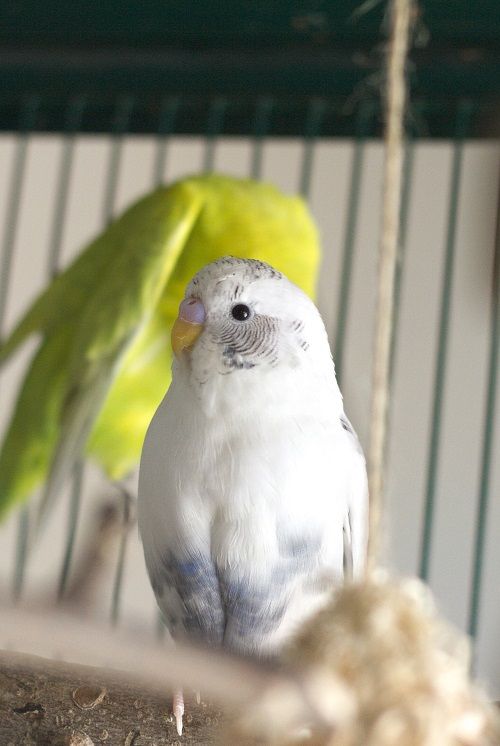
How to train a parakeet step 3: Tricks
Alright, congratulations! If your parakeet has all the basics down and feels comfortable around you, you can pat yourself on the back. It takes a lot of patience and you’ve hopefully established a good bond with your bird at this point.
Now, let’s move on to the most fun part: how to train a parakeet to do tricks. There are seriously so many options. Have your bird skateboarding around the house, holding up notes with writing, dunking a basketball, or even playing dead.
All this begs the question: how the heck am I supposed to get my parakeet to dunk a basketball or ride around on a skateboard? It’s actually easier than you think. There’s a little trick to it called target training, which can be applied to teach almost anything.
Target training
- You’ll need a small stick. I like using a chopstick or a colorful pencil.
- Hold the stick up to your parakeet. If it’s comfortable around you and new things, it will probably not be able to resist giving the stick a nibble to inspect it.
- REWARD! If the bird touches the stick, praise it into the heavens (including saying your ‘praise phrase’ or clicking your clicker) and give it a treat.
- Repeat this until your parakeet knows that it’ll receive a treat if it touches the stick when it’s presented.
- You’ll find that your parakeet will follow the stick everywhere, trying to touch it with its beak to receive that coveted bit of food.
You might have realized where we’re going with this. Now that your ‘keet is obsessed with this stick, you can use it to easily guide the bird around! If you want to teach it to twirl in place, for example, you can use this stick to your advantage.
Make your bird turn in a circle in its attempts to get to the stick. While you do, say something like ‘twirl!’ and make a twirling movement with your finger as an extra cue. Reward a completed twirl with a click/praise and some food.
Eventually, you won’t need the stick anymore. Just saying ‘twirl!’ and the finger cue will be enough.
Did you know? These tricks are not just for fun. They’re useful too! Learning new things is a way for your parrot to use that super smart brain and prevent boredom. The attention you give helps fulfill your bird’s social needs.
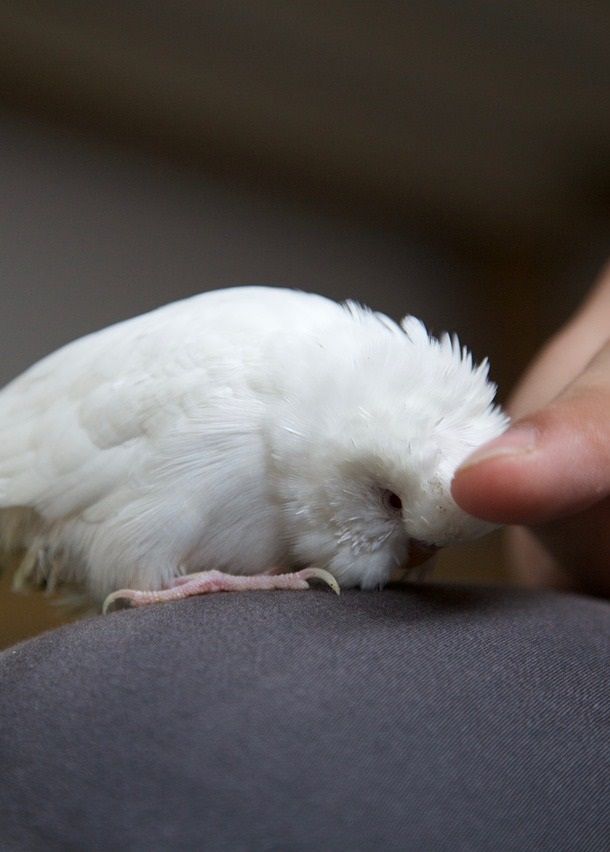
Bonus: Clicker training
In the above, we briefly touched on auditory praise. Saying something like ‘good bird!’ every time your parakeet performs a trick correctly can really help cement tricks for them. Especially when the phrase is followed by a treat, of course!
Instead of saying ‘good bird!’ you can also opt to go for a clicker. You might have heard of the concept of clicker training, where you use a little device to make a clicking noise every time a trick is performed correctly.
At first, you’ll have to follow the order of command → click → reward. However, eventually, you won’t need to give a treat every single time anymore. Just a click is enough. The trick has truly been cemented into your bird’s mind.
- EASY TO USE – Simple push button with distinct clicking sound.
- Comes with an elastic wrist band so you can leave it on your wrist or clip it to the leash or your…
- Not only train the dog but also the cat, bird, chicken, sheep a new behaviors like sit, fetch, roll…
- For effective pet training ALWAYS reward with a treat after clicking.
- Can be used to train the dog basic obedience, small trick, and correct the bad behavior; Scientific…
How to get your parakeet to talk
Perhaps the most fun type of training you can do with your parakeet is talking training. Many parakeet species are on the list of best talking parrots, including budgies and Indian ringnecks.
You can find out everything you need to know about talking training in the article about parakeet talking.
Troubleshooting
Running into trouble? It’s normal, training any animal is not a straight line to success. And much less an animal as smart as a parakeet!
Here are some things that might help you troubleshoot:
- Make sure your parakeet is not distracted during training. Going into a quiet room for a training session can help.
- What do you do if your parakeet displays an unwanted behavior? After all, it won’t understand punishment. Well, the best thing you can do is to simply ignore and/or redirect to a positive behavior.
- Some parakeets just don’t take well to certain tricks. If something is really not working, just switch it up!
- Remember to also train yourself. That is, your patience and insight into the needs of your bird. It can be hard to understand sometimes why it does certain things, but you can’t lose your temper. It’s just a bird being a bird.
If you have any more questions about how to train a parakeet or would like to share your own experiences, don’t hesitate to leave a comment below!
Sources & further reading
Heidenreich, B. (2007). An introduction to positive reinforcement training and its benefits. Journal of Exotic Pet Medicine, 16(1), 19-23.

